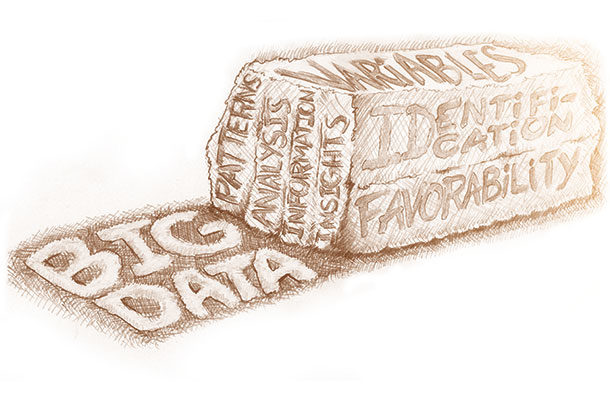“Big data” has recently become a buzz word in the agriculture sector. Before we get into whether agricultural big data is good, bad or otherwise, we need to define what is meant by big data.
Our lives are filled with electronic devices connected to the Internet. All of these devices make our lives very convenient by saving our search results, giving us an account so our shipping information is saved and giving rewards programs at your local store. These conveniences and deals are seemingly free of charge.
However, there is an underlying reason you are receiving these services pro bono, which is that companies are able to collect some useful data. When I use my rewards card at a store, the number on that card is associated with me and what I buy.
The store benefits by learning from me (and literally millions of other customers) what and when we buy certain things so they can offer sales at the right time. This ensures they retain us as customers and we continue to shop with them.
Similarly, have you noticed how search engines and websites show you nice advertisements on a product you were thinking about buying three days ago? If you were logged in to your account and searched for a certain item, they will place advertisements for selected retail outlets right in your line of sight on any page they control. The data these companies collect is a form of big data, and statistical analysis of this data can reveal trends that benefit companies.
The concept is similar when speaking about agricultural big data. The new machines used for day-to-day field operations are loaded with sensors and communication systems (controller area networks and telematics systems) that allow them to sense and optimize field operations.
Some tractors can sense when a part or sensor is going bad on the machine, notify the local dealer of the pending issue and even go so far as to ship or deliver the new part very close to the day it actually breaks on the machine.
In this example, a big data analysis could be done to realize what part is failing, when it will fail, what geographical areas have more of these parts failing, and the manufacturing company would be able to re-route supply chains for that part to get replacements to areas of the country where they will soon be needed. This analysis greatly benefits the producer who is relying on that tractor to get a field operation complete within an optimum weather window.
Big data analysis is only starting to be applied to crops and promises some great potential with aggregated analysis. Aggregated analysis is done by making similar data from multiple producers anonymous, lumping it all together and analyzing that data as one large dataset. For example, let’s assume I plant a certain variety of crop (variety A) in three various soil types across my fields.
I then keep records of everything that was done to that crop from planting date, fertilization, pesticide applications, harvest dates, yield, etc. Then I do the same thing with another variety (variety B) on similar soil types with equal input treatments. I can compare the production of the two varieties within the confines of my farm and for that particular year, but that only gives me a snapshot of performance for those particular varieties.
Now consider if every farmer growing variety A and variety B were to provide an analysis company with all this information I just described – but over multiple years.
What would be gained is the in-depth knowledge of how variety A and variety B perform in varying weather conditions, soil types, geographic regions, etc. Then producers attempting to choose the ideal variety for their particular field would have more information than ever before and hopefully a better chance at a profitable variety selection for any given growing season.
This is not a perfect system, however, due to weather uncertainty, but as this data is collected over time in varying weather conditions from year to year, the effects of weather can be averaged and crop response and spatial variation can be more readily identified.
What does this mean for forage producers? Management of forage crops is not so different than management of row crops, and a lot of the same best practices apply. For example, geo-referencing soil samples either on a grid pattern or zone pattern within the field provides spatial variation information for crop nutrients. Having a record of historical soil sampling results provides insight into soil health and nutrient removal from harvest of the forage crop.
Irrigation management is another good example where soil moisture sensors or spatial soil electrical conductivity measurements that determine water-holding capacity can be utilized in management decisions. Equipment-based data like auto-guidance/swath control, crop moisture sensors, yield monitors, baler monitors and bale tracking and preservative monitoring can all be included in an aggregated data analysis program.
Recently, remote sensing has provided insight into crop health and vigor, whether it be machine-based, unmanned aerial vehicle-based or satellite-based.
These measurements provide insight into spatial variations in plant growth and can be attributed to water stress, nutrient deficiencies, disease, pest damage, etc. The take-home message is: Keeping good farm records about field operations, preferably with a spatial component, will potentially be beneficial and aid in later management decisions.
Even if you are not planning in participating in a data analysis program in the near future, having these records could provide valuable information later if you do participate.
Some things to consider before participating in a data storage and analysis program are:
- Ensure the company you are working with is reputable and has experience in the agriculture sector.
- Ensure you understand what deliverables the company will provide for having access to your data.
- Understand what will happen to your data once the relationship between you and the provider is terminated.
- Read and understand the service agreement or “terms of use” between you and the service provider with regards to privacy and data sharing.
- Always keep a back-up of the original data files for future reference. A company who is a good steward of your data will readily provide this information and be very clear when asked about these topics.
The American Farm Bureau Federation has put together some guidelines for companies that are geared toward the interest of producers.
Collection and analysis of “big data” in the agricultural sector stands to provide more information to management decisions than ever before. Aggregated analysis of this data could benefit producers greatly and hopefully increase profit margins. If care is taken when selecting a data analysis provider, any potential problems will be mitigated. FG
Brian D. Luck is an assistant professor and extension specialist - machinery systems and precision agriculture with the University of Wisconsin – Madison. Email Brian D. Luck.
GRAPHIC: Graphic by Corey Lewis.










